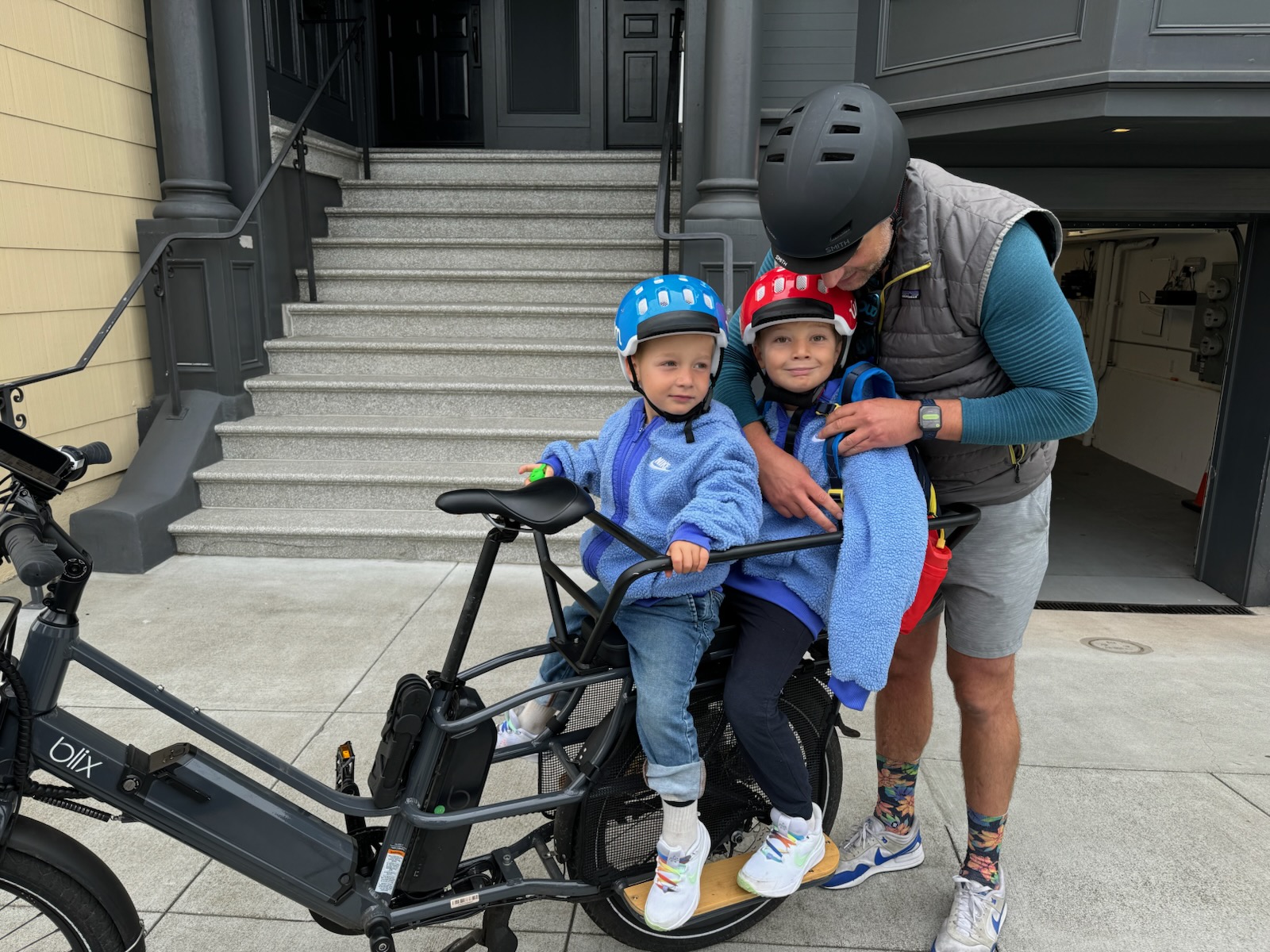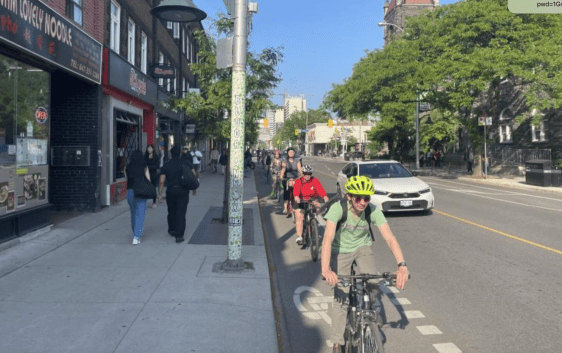 ⁞Cyclists disappear in bus lane while a pedestrian bolts across the street in South London.
⁞Cyclists disappear in bus lane while a pedestrian bolts across the street in South London.Editor's note: While changes appear to be in the works in London on the public space realm (check out our latest Streetfilm posted today), Chris Carlsson got a slightly different take when he visited there last week.
I'm on a book tour in the UK so I thought I'd send in a quick report on the street conditions in London. I was only in town for a couple of days, so necessarily anything I write is rather impressionistic, but I've been here before and it was interesting to see the difference, even from two years ago. There are a lot more cyclists on the road! A LOT more!... I had to do a lot of bus riding, so I sat up top on those great London double-deckers, right in front, and took lots of photos. Somehow I could never get my camera on in time to catch the ubiquitous clusters of cyclists that would appear suddenly on side streets, or stream across the intersection a half block ahead of me. It was quite common to see groups of 5-10 bicyclists, usually decked out as commuters with chartreuse vests and helmets, briefcases and panniers, whilst riding along in business drag beneath the gear.
 Cyclists huddle along edge of road while awaiting a light change, typical in London. The double yellow line is basically the available space dedicated to cycling on many streets.
Cyclists huddle along edge of road while awaiting a light change, typical in London. The double yellow line is basically the available space dedicated to cycling on many streets.I managed to catch some photos of street life, which I hope give an idea of the sheer insanity of London's urban fabric. The new-ish mayor, the conservative Blonde Boris, made a lot of noise about being a cyclist while he ran for office, but since he's become the city's executive, according to friends he's cutting back on the fairly successful congestion tax (8 pounds every time you enter a larger central area), and has put very little effort into extending or improving conditions for cycling, walking, or anything not associated with private cars and parking. The basic reality for London cyclists is that they're expected to snake along a very narrow bit of asphalt near the curb (all on the left side, since it's the UK), and are continually being hemmed in by towering double-decker buses, and quite frequently trapped when a sudden construction zone appears, blocking the curbside zone. I saw a half dozen cyclists jump on the sidewalk near the London Bridge to get out of a completely blocked spot due to construction. Throughout my time in London I was really taken aback by the sheer numbers of cyclists, nothing like it was when I came in 1999, or even in 2007 (though you could see it starting to happen two years ago).
 This guy is squeezing past the bus, in about 18" of curbside road space!
This guy is squeezing past the bus, in about 18" of curbside road space!It seems that between various mainstream cycling campaigns and the dynamic and large Critical Mass rides that London has enjoyed going back to the early 1990s, much like San Francisco, thousands of new cyclists have taken to the bike as a preferable alternative to cars and painfully slow tube and buses. But the paltry bike lanes (half as wide as San Francisco's sorry collection), while nicely colored green, are only a bit wider than the 18" or so that cyclists are shunted in to on most of London's streets. And of course there aren't that many of them anyway. (For a refreshing look at a city that does it right, take a look at this cool blog). This forces London cyclists to behave like motorists and integrate with the flow of traffic (while I saw riders in mid-lane all the time, I also enjoyed watching them take lanes as needed and quickly slide through stuck traffic as needed too, a routine practice of local bicyclists), in ways most San Franciscans would find pretty terrifying. But all kinds of riders were out there in mid-traffic, from couriers to commuters to little old ladies and students going to school.
 These are the new green bike lanes, about half the width we're used to in California.
These are the new green bike lanes, about half the width we're used to in California.Meanwhile, the larger picture of London life bubbles along. Rapidly rising unemployment, insecurity, and financial disaster are the story here too.
 Corporate wannabes on lunch breaks.
Corporate wannabes on lunch breaks.Already corporations are closing factories, and in a galvanizing moment, fraught with contradiction, workers at a Visteon auto parts plant have embarked on the first workplace occupation in many years in England. I was encouraged to come and visit the occupation, but too late, and could not rearrange my schedule in time. It would have been quite interesting to discuss the future with auto parts workers who are taking direct action to protect their lives, but are stuck in an industry whose time is clearly over. This in turn harkens back to the late 1970s, when Britain was downsizing its military production industries during the recession of that period, and the workers of Lucas Aerospace took the initiative, along with ecological activists, anti-nuclear and anti-military campaigners, to devise a very broad and comprehensive plan for converting their facilities to producing solar, wind, and other "clean, peaceful" technologies, as imagined at the time. I asked my friends in London if the Lucas Aerospace story had been in the air at all, especially around the Visteon occupation, but they said they didn't think so, that Lucas was lost in the mists of time. It was a full generation ago, and became the object of much academic attention for a while, but is now fairly well forgotten everywhere, not least because it was not successful! If you're interested in going back 30 years to see how the discussions about science and technology and labor processes were unfolding, click this link for a pdf called "Science and the Labour Process."
All this forgotten stuff haunts today's discussions about how to cope with the economic and ecological collapses, and would, if studied a bit, provide a useful deepening to the Transition Town/Resilient Community discussions. (This is a strong movement here in the UK, and taking off in the U.S. now too... more on that in a later dispatch.)
 South London public housing and their adjacent garden plots... a seedbed for transition!
South London public housing and their adjacent garden plots... a seedbed for transition!



